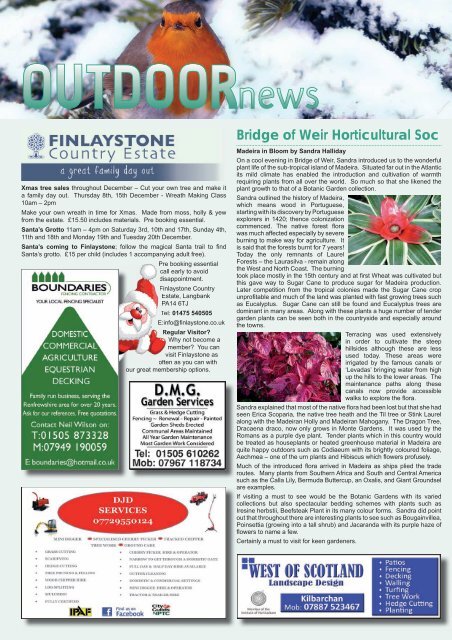267 December 2016 - Gryffe Advertizer
The Advertizer - Your local community magazine to the Gryffe area.
The Advertizer - Your local community magazine to the Gryffe area.
Create successful ePaper yourself
Turn your PDF publications into a flip-book with our unique Google optimized e-Paper software.
50 the advertizer t: 01505 613340 07731 923970 e: info@advertizer.co.uk<br />
Xmas tree sales throughout <strong>December</strong> – Cut your own tree and make it<br />
a family day out. Thursday 8th, 15th <strong>December</strong> - Wreath Making Class<br />
10am – 2pm<br />
Make your own wreath in time for Xmas. Made from moss, holly & yew<br />
from the estate. £15.50 includes materials. Pre booking essential.<br />
Santa’s Grotto 11am – 4pm on Saturday 3rd, 10th and 17th, Sunday 4th,<br />
11th and 18th and Monday 19th and Tuesday 20th <strong>December</strong>.<br />
Santa’s coming to Finlaystone; follow the magical Santa trail to find<br />
Santa’s grotto. £15 per child (includes 1 accompanying adult free).<br />
Pre booking essential<br />
call early to avoid<br />
disappointment.<br />
Finlaystone Country<br />
Estate, Langbank<br />
PA14 6TJ<br />
Tel: 01475 540505<br />
E:info@fi nlaystone.co.uk<br />
Regular Visitor?<br />
Why not become a<br />
member? You can<br />
visit Finlaystone as<br />
often as you can with<br />
our great membership options.<br />
Bridge of Weir Horticultural Soc<br />
Madeira in Bloom by Sandra Halliday<br />
On a cool evening in Bridge of Weir, Sandra introduced us to the wonderful<br />
plant life of the sub-tropical island of Madeira. Situated far out in the Atlantic<br />
its mild climate has enabled the introduction and cultivation of warmth<br />
requiring plants from all over the world. So much so that she likened the<br />
plant growth to that of a Botanic Garden collection.<br />
Sandra outlined the history of Madeira,<br />
which means wood in Portuguese,<br />
starting with its discovery by Portuguese<br />
explorers in 1420; thence colonization<br />
commenced. The native forest flora<br />
was much affected especially by severe<br />
burning to make way for agriculture. It<br />
is said that the forests burnt for 7 years!<br />
Today the only remnants of Laurel<br />
Forests – the Laurasilva - remain along<br />
the West and North Coast. The burning<br />
took place mostly in the 15th century and at first Wheat was cultivated but<br />
this gave way to Sugar Cane to produce sugar for Madeira production.<br />
Later competition from the tropical colonies made the Sugar Cane crop<br />
unprofitable and much of the land was planted with fast growing trees such<br />
as Eucalyptus. Sugar Cane can still be found and Eucalyptus trees are<br />
dominant in many areas. Along with these plants a huge number of tender<br />
garden plants can be seen both in the countryside and especially around<br />
the towns.<br />
Terracing was used extensively<br />
in order to cultivate the steep<br />
hillsides although these are less<br />
used today. These areas were<br />
irrigated by the famous canals or<br />
‘Levadas’ bringing water from high<br />
up the hills to the lower areas. The<br />
maintenance paths along these<br />
canals now provide accessible<br />
walks to explore the fl ora.<br />
Sandra explained that most of the native flora had been lost but that she had<br />
seen Erica Scoparia, the native tree heath and the Til tree or Stink Laurel<br />
along with the Madeiran Holly and Madeiran Mahogany. The Dragon Tree,<br />
Dracaena draco, now only grows in Monte Gardens. It was used by the<br />
Romans as a purple dye plant. Tender plants which in this country would<br />
be treated as houseplants or heated greenhouse material in Madeira are<br />
quite happy outdoors such as Codiaeum with its brightly coloured foliage,<br />
Aechmea – one of the urn plants and Hibiscus which flowers profusely.<br />
Much of the introduced flora arrived in Madeira as ships plied the trade<br />
routes. Many plants from Southern Africa and South and Central America<br />
such as the Calla Lily, Bermuda Buttercup, an Oxalis, and Giant Groundsel<br />
are examples.<br />
If visiting a must to see would be the Botanic Gardens with its varied<br />
collections but also spectacular bedding schemes with plants such as<br />
Iresine herbstii, Beefsteak Plant in its many colour forms. Sandra did point<br />
out that throughout there are interesting plants to see such as Bougainvillea,<br />
Poinsettia (growing into a tall shrub) and Jacaranda with its purple haze of<br />
flowers to name a few.<br />
Certainly a must to visit for keen gardeners.


















